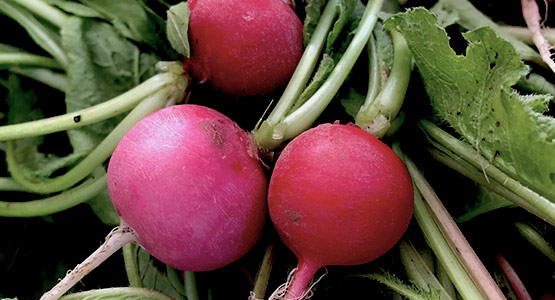We live in a world that advocates extreme measures. Gained a few pounds over the winter? Ingest nothing but kale smoothies for 14 days. Piggy-back your efforts with a hard-core cleanse. Take energy supplements so you can take it to the limit at the gym. It all adds up to pushing your body even further out of alignment.
Ayurveda advocates common sense, grounded in recognition that we were designed to exist in harmony with nature. It’s all about tweaking your daily diet and lifestyle choices to stay in your groove. Small changes. Subtle shifts. Along the way, Mother Nature provides remedies through the bounties of each season.
A Perfect Example of Ayurvedic Wisdom
It’s springtime (Kapha season). The earth’s energy is stabilizing, grounding and moist. You feel it every day. Just look outside. The world is offering a container for life.
Your body naturally desires alignment. Have you noticed any cravings for something crisp, light and slightly spicy? This is your body suggesting what will bring alignment your way. Metaphorically, your “spicy” craving could be a sign that you want to spice up your life…or that you need to “lighten-up.” More importantly, it is your body telling you that it is time to compensate for seasonal changes. Listen and change up your diet a bit.
Enter the radish. Yes, this early spring vegetable is currently available at local farmers’ markets. From an Ayurvedic standpoint, something as simple as the radish can be an effective remedy for a spring craving. The radish has the qualities you desire. You can eat the entire radish plant (go greens!) using a variety of preparation methods like roasting, grilling, or steaming.
The Radish Factor
Factor radishes into several meals throughout the week, and here’s a little taste of what you get:
- A hefty dose of vitamin C: Radishes contain a significant amount of vitamin C (about 25% of the daily recommended value per 100-gram serving), which helps to rebuild tissues and blood vessels, while keeping bones and teeth strong. As a water-soluble, antioxidant vitamin (that must be replaced daily), it protects cells from free radicals and increases your immunity to protect against cancer, heart disease, stroke, and other diseases.
- Reduction of “puffiness”: The potassium in radishes makes this vegetable a natural diuretic, which helps to eliminate some of the water you might be retaining now (a classic Kaphic seasonal annoyance).
- Relief from congestion, colds and respiratory problems: With their antibacterial and detoxifying properties, zingy radishes are great for busting-up Kapha blockages and clearing out passages.
- A digestive boost: Heavy, dense Kapha energy is known to bring about sluggishness. Pungent radishes offset this by stimulating your digestion.
- Help moving past pesky elimination issues: Constipation can take the spring out of your step. Radishes are a good source of fiber, which helps to keep your system regular, flushed and correctly functioning.
- A micro cleanse: On the heels of a heavier, oilier diet throughout the winter, spring is a time to be mindful of enabling clear flow in your body. The buildup of bilirubin, for example, inhibits proper liver function. This, in turn, interferes with the effective breakdown of fat. Radishes’ micronutrients aid in cleaning the liver and blood. They help to remove bilirubin so your body’s “cleaning crew” works the way it should.
We are all Unique
As with any Ayurvedic remedy, there are considerations in deciding which choices are best for you in the moment. It is not a “one size fits all” science. Ayurveda recognizes your uniqueness. So….without deflating our example of the mighty radish too much, below are some scenarios to consider.
In Ayurveda, the preparation method used is as significant as food choices. In the spring, for example, heavy sautéing is typically not a recommended method. It adds to the “weight” of Kapha and introduces added oils and butters that can be a drag on the liver.
Experiencing annoying bouts of gas?
Avoid raw radishes and opt for roasting or steaming. Raw foods are especially tough on the digestive system. Plus, the light qualities of radishes can intensify the impact of flighty Vata energy and produce an unwanted by-product.
Thyroid issues?
Again, steer clear of raw radishes. Like other cruciferous vegetables, radishes are known to have goitrogenic compounds that can interfere with thyroid hormone production. These compounds are de-activated during the cooking process.
Aggravated by the increase of Pitta’s heat in spring?
A radish’s pungent taste and heating “zing” might not be for you.
Mindful of Daily Choices
Wellbeing comes with being mindful of your daily choices, while keeping an eye on the big picture. Through the simple example of a spring radish, it is easy to illustrate how everyday food choices can support or undermine your wellbeing. Ayurveda teaches us that the key is to pay attention to seasonal shifts and to the signals your body is providing. The two go hand-in-hand. And effortless changes are always better than extreme measures.
In the grand scheme of things, doesn’t adding a radish to your meal here and there make a lot of sense?


